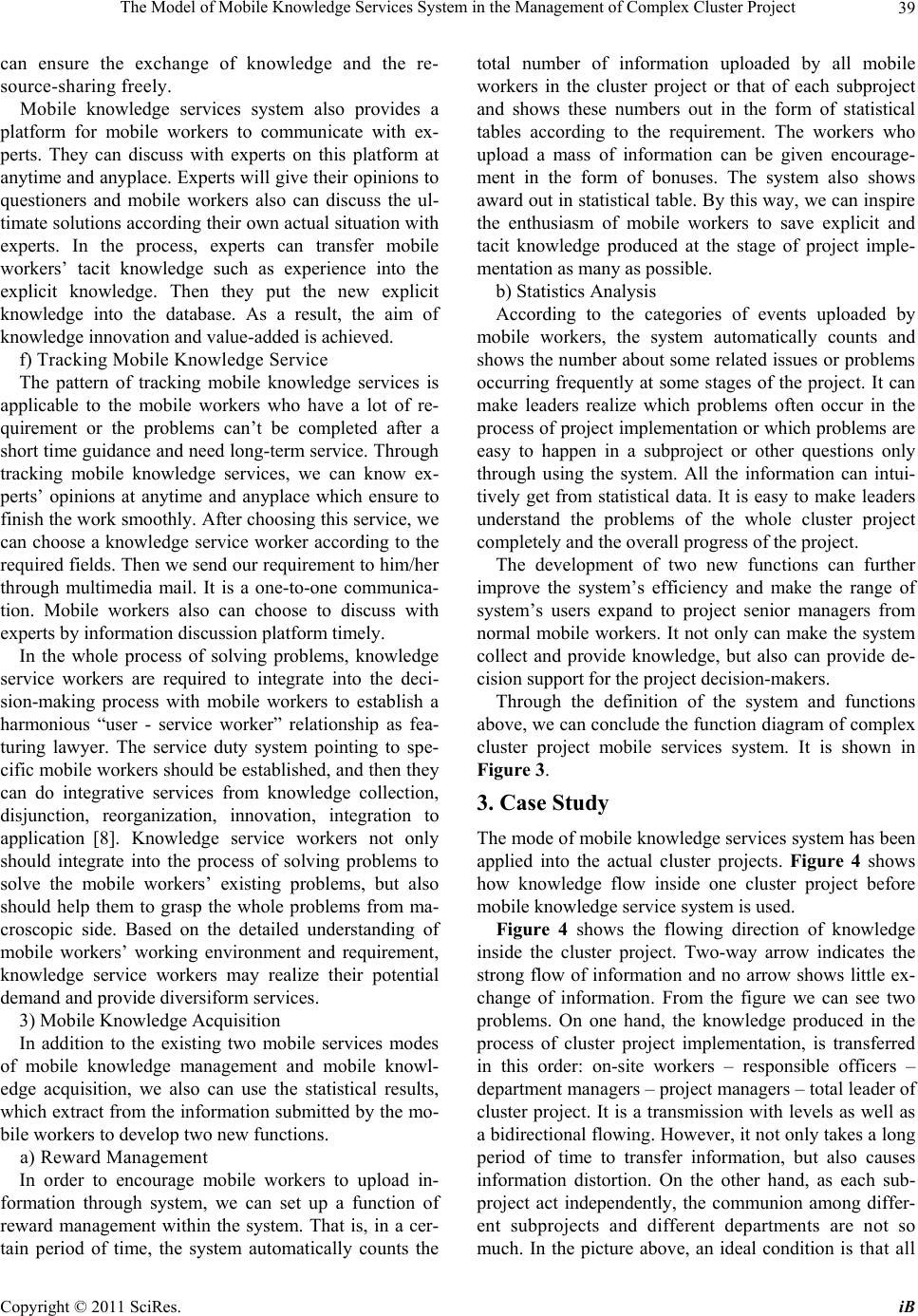
The Model of Mobile Knowledge Services System in the Management of Complex Cluster Project39
can ensure the exchange of knowledge and the re-
source-sharing freely.
Mobile knowledge services system also provides a
platform for mobile workers to communicate with ex-
perts. They can discuss with experts on this platform at
anytime and anyplace. Experts will give their opinions to
questioners and mobile workers also can discuss the ul-
timate solutions according their own actual situation with
experts. In the process, experts can transfer mobile
workers’ tacit knowledge such as experience into the
explicit knowledge. Then they put the new explicit
knowledge into the database. As a result, the aim of
knowledge innovation and value-added is achieved.
f) Tracking Mobile Knowledge Service
The pattern of tracking mobile knowledge services is
applicable to the mobile workers who have a lot of re-
quirement or the problems can’t be completed after a
short time guidance and need long-term service. Through
tracking mobile knowledge services, we can know ex-
perts’ opinions at anytime and anyplace which ensure to
finish the work smoothly. After choosing this service, we
can choose a knowledge service worker according to the
required field s. Then we send our requ irement to him/her
through multimedia mail. It is a one-to-one communica-
tion. Mobile workers also can choose to discuss with
experts by information discussion platform timely.
In the whole process of solving problems, knowledge
service workers are required to integrate into the deci-
sion-making process with mobile workers to establish a
harmonious “user - service worker” relationship as fea-
turing lawyer. The service duty system pointing to spe-
cific mobile workers should be established, and then they
can do integrative services from knowledge collection,
disjunction, reorganization, innovation, integration to
application [8]. Knowledge service workers not only
should integrate into the process of solving problems to
solve the mobile workers’ existing problems, but also
should help them to grasp the whole problems from ma-
croscopic side. Based on the detailed understanding of
mobile workers’ working environment and requirement,
knowledge service workers may realize their potential
demand and provide diversiform services.
3) Mobile Knowledge Acquisition
In addition to the existing two mobile services modes
of mobile knowledge management and mobile knowl-
edge acquisition, we also can use the statistical results,
which extract from the information submitted by the mo-
bile workers to develop two new functions.
a) Reward Management
In order to encourage mobile workers to upload in-
formation through system, we can set up a function of
reward management within the system. That is, in a cer-
tain period of time, the system automatically counts the
total number of information uploaded by all mobile
workers in the cluster project or that of each subproject
and shows these numbers out in the form of statistical
tables according to the requirement. The workers who
upload a mass of information can be given encourage-
ment in the form of bonuses. The system also shows
award out in statistical table. By this way, we can inspire
the enthusiasm of mobile workers to save explicit and
tacit knowledge produced at the stage of project imple-
mentation as many as possible.
b) Statistics Analysis
According to the categories of events uploaded by
mobile workers, the system automatically counts and
shows the numbe r about some related issues or prob lems
occurring frequently at some stages of the project. It can
make leaders realize which problems often occur in the
process of project implementation or which problems are
easy to happen in a subproject or other questions only
through using the system. All the information can intui-
tively get from statistical data. It is easy to make leaders
understand the problems of the whole cluster project
completely and the overall progress of the project.
The development of two new functions can further
improve the system’s efficiency and make the range of
system’s users expand to project senior managers from
normal mobile workers. It not only can make the system
collect and provide knowledge, but also can provide de-
cision support for the project decision-makers.
Through the definition of the system and functions
above, we can conclude the function diagram of complex
cluster project mobile services system. It is shown in
Figure 3.
3. Case Study
The mode of mobile knowledge services system has been
applied into the actual cluster projects. Figure 4 shows
how knowledge flow inside one cluster project before
mobile knowledge service system is used.
Figure 4 shows the flowing direction of knowledge
inside the cluster project. Two-way arrow indicates the
strong flow of information and no arrow shows little ex-
change of information. From the figure we can see two
problems. On one hand, the knowledge produced in the
process of cluster project implementation, is transferred
in this order: on-site workers – responsible officers –
department managers – project managers – total leader of
cluster project. It is a transmission with levels as well as
a bidirectional flowing. However, it n ot only takes a lo ng
period of time to transfer information, but also causes
information distortion. On the other hand, as each sub-
project act independently, the communion among differ-
ent subprojects and different departments are not so
much. In the picture above, an ideal condition is that all
Copyright © 2011 SciRes. iB